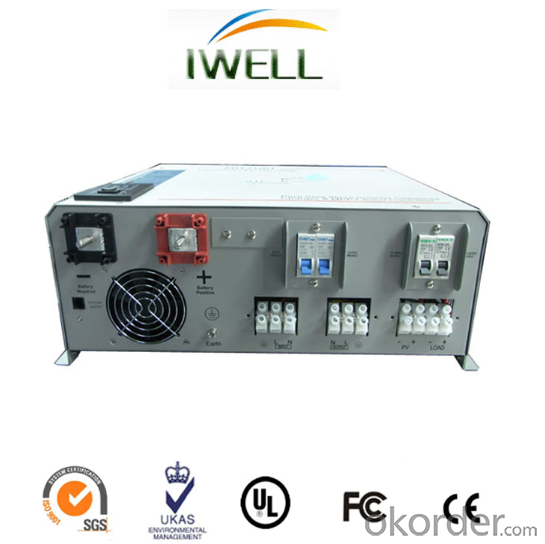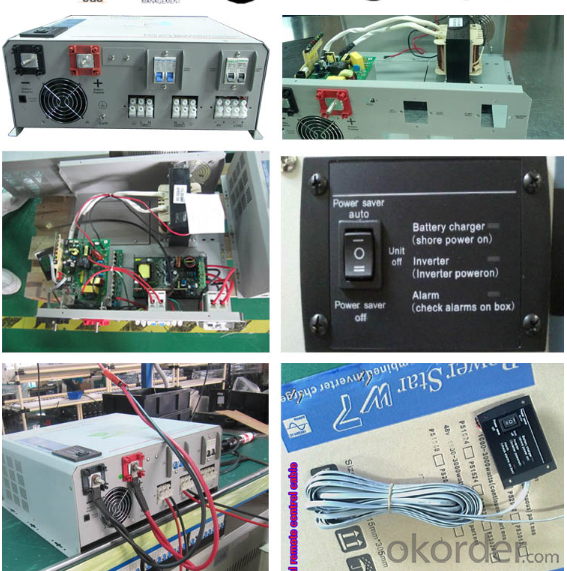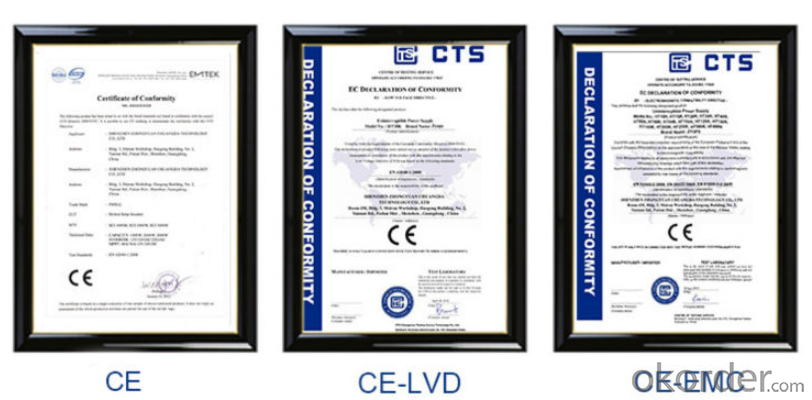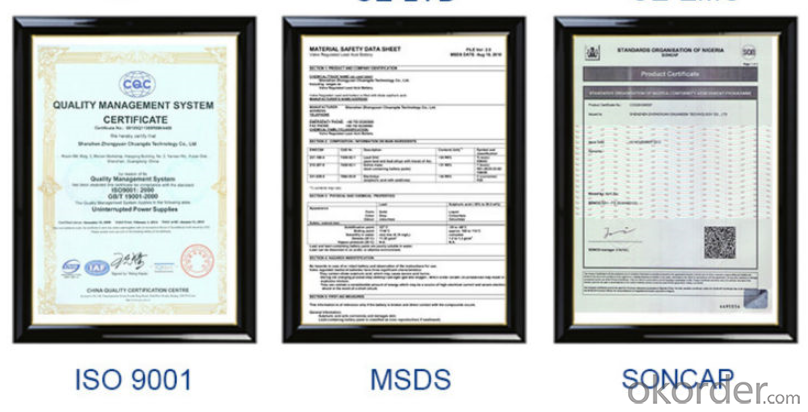Solar System 12V 24V 1-3KW Inverter with Controller and Charger Pure Sine Wave
- Loading Port:
- Qingdao
- Payment Terms:
- TT or LC
- Min Order Qty:
- 50 unit
- Supply Capability:
- 3000 unit/month
OKorder Service Pledge
OKorder Financial Service
You Might Also Like
1. Structure of Solar System 12V 24V 1-3KW Inverter with Controller and Charger Pure Sine Wave
A solar inverter, or PV inverter, or Solar converter, converts the variable direct current (DC) output of a photovoltaic (PV) solar panel into a utility frequency alternating current (AC) that can be fed into a commercial electrical grid or used by a local, off-grid electrical network.
It is a critical BOS–component in a photovoltaic system, allowing the use of ordinary AC-powered equipment.
Solar inverters have special functions adapted for use with photovoltaic arrays, including maximum power point tracking and anti-islanding protection.
2. Main Features of the Solar System 12V 24V 1-3KW Inverter with Controller and Charger Pure Sine Wave
﹒Output waveform: pure sine wave
﹒High efficiency>85%
﹒12v or24v or 48vDC input
﹒AC100V or AC110V or AC120V/220v /230V /240V AC output
﹒Output frequency 60HZ or 50HZ
﹒Continuous output power:10KW
﹒High-velocity cooling fan
﹒Overload protect ,over voltage protect ,low voltage cut-out ,low voltage alarm
3. Solar System 12V 24V 1-3KW Inverter with Controller and Charger Pure Sine Wave Images





4. Solar System 12V 24V 1-3KW Inverter with Controller and Charger Pure Sine Wave Specification
Mode | PTV 500W | PTV 1000W | PTV 1500W | PTV 2000 | PTV 3000 |
Continuous power (W) | 500W | 1000W | 1500W | 2000W | 3000W |
Surge capability (W) | 1500W | 3000W | 4500W | 6000W | 6000W |
System DC input (VDC) | 12VDC | 24VDCV | 24VDC | 24VDC | 24VDC |
AC Output | 110 / 120V/ 220V/230V ±5% , 50HZ or 60HZ. Terminal | ||||
AC Output waveform | Pure Sine Wave | ||||
DC output | 12VDC or 24VDC Terminal | ||||
Efficiency | 88% | ||||
AC/DC Charger | Max 15A | Max 25A | Max 25A | Max 40AMP | Max 50 |
Solar Charge Controller | MPPT,20AMP | MPPT,30AMP | MPPT,40AMP | MPPT,50AMP | MPPT 100AMP |
Adviced PV | 36 or 72 Cell | 72 Cell | 72 Cell | 72 Cell | 72 Cell |
External battery back | 12 or 24VDC | 24VDC | 24VDC | 24VDC | 24VDC |
Breakers | with Breakers for AC Input , AC output, PV input , DC output | ||||
Battery low protection | yes | ||||
Over discharge protection | yes | ||||
Resume voltage | yes. When fault remove | ||||
Over voltage protection | yes | ||||
Overload protection | yes. | ||||
With cooling fan | yes | ||||
Display | LED for Inverter,charger,Battery Capacity state, DC load state and fault. LCD display is optional | ||||
Running Temperature | -35 degree to 55 degree | ||||
High temperature protection | YES | ||||
Short circuit protection | YES | ||||
Reverse polarity protection | YES. Only for DC load side. | ||||
Stand by | yes. continou ouput while > 25W | ||||
Communication | RS232 Power Manager, NetAgent SNMP , Optional for LED mode | ||||
Package Size(mm) | 608*558*293 | 608*558*293 | 608*558*293 | 608*558*293 | 608*558*293 |
Gross Weight KG | 21 | 24 | 24 | 26 | 32 |
product Size (mm) | 460*440*200 | 460*440*200 | 460*440*200 | 460*440*200 | 460*440*200 |
product weight( kg) | 15KG | 16KG | 16KG | 19.5KG | 24KG |
5. FAQ of Solar System 12V 24V 1-3KW Inverter with Controller and Charger Pure Sine Wave
Q1. What is the difference between inverter and solar inverter?
A1. Inverter only has AC inpput, but solar inverter both connect to AC input and solar panel, it saves more power.
Q2. What is the difference between MPPT&PWM?
A2. MPPT has higher efficiency, it can track the max power point and won't waste energy.
Q3. What is the waranty of product?
A3. 12 months.
- Q:Can a solar inverter be used with a net metering system?
- Yes, a solar inverter can be used with a net metering system. In fact, a solar inverter is an essential component of a net metering system. It converts the direct current (DC) electricity generated by the solar panels into alternating current (AC) electricity that can be used to power the home or business. The excess electricity produced by the solar panels is fed back into the grid through the net meter, allowing the utility company to credit the owner for the excess energy produced.
- Q:Can a solar inverter be used with a solar-powered remote monitoring system?
- Yes, a solar inverter can be used with a solar-powered remote monitoring system. The solar inverter is responsible for converting the direct current (DC) generated by the solar panels into alternating current (AC) that can be used to power various devices, including the remote monitoring system. This allows the remote monitoring system to be powered by the solar panels and ensures that it operates efficiently.
- Q:What are the methods of photovoltaic grid-connected inverter control
- Sine wave output inverter control integrated circuits, sine wave output of the inverter, the control circuit can be used microprocessor control, such as INTEL company produced 80C196MC, Motorola produced MP16 and MI-CROCHIP company PIC16C73 and so on, these single-chip microcomputer has a multi-channel PWM generator,
- Q:Can a solar inverter be used with different types of electrical appliances?
- Yes, a solar inverter can be used with different types of electrical appliances as long as the appliances are compatible with the inverter's power output. The inverter converts the direct current (DC) generated by the solar panels into alternating current (AC), which can be used to power various electrical devices. However, it is important to ensure that the inverter's capacity and voltage output are suitable for the specific appliances to avoid damage or malfunction.
- Q:Solar grid inverter does not merge into the grid, direct access to the load to the load power supply?
- Inverter is the DC power (battery, battery) into alternating current (usually 220V, 50Hz sine wave). It consists of inverter bridge, control logic and filter circuit
- Q:Can a solar inverter be connected to a home automation system?
- Yes, a solar inverter can be connected to a home automation system. This integration allows for better control and monitoring of the solar energy production and enables homeowners to optimize their energy usage based on real-time data.
- Q:Can a solar inverter be used with a solar-powered electric gate system?
- Yes, a solar inverter can be used with a solar-powered electric gate system. The solar inverter converts the direct current (DC) generated by the solar panels into alternating current (AC) that is required to power the electric gate system. This allows the solar energy captured by the solar panels to be utilized effectively in operating the electric gate system.
- Q:What is the role of a solar inverter in maintaining system stability?
- The role of a solar inverter in maintaining system stability is to convert the direct current (DC) produced by solar panels into alternating current (AC) that can be used by household appliances and fed back into the electrical grid. By regulating the voltage and frequency of the AC output, the inverter ensures that the solar system operates within the acceptable range, preventing overloading or damaging the connected devices. Additionally, solar inverters also help to synchronize the solar system with the grid, allowing for smooth integration and optimal energy flow. Overall, the solar inverter plays a crucial role in maintaining the stability and efficiency of the solar power system.
- Q:Can a solar inverter be used with a monitoring system?
- Yes, a solar inverter can be used with a monitoring system. In fact, many solar inverters come with built-in monitoring capabilities, allowing users to track and analyze the performance of their solar energy system in real-time. Additionally, there are also external monitoring systems available that can be connected to the solar inverter to provide more detailed data and insights on energy production, consumption, and system efficiency.
- Q:How does the total harmonic distortion affect the performance of a solar inverter?
- Total harmonic distortion (THD) refers to the measure of distortion or deviation from the ideal sine wave in an electrical system. In the case of a solar inverter, high THD levels can negatively impact its performance. Excessive harmonic distortion can lead to increased heat generation, reduced power efficiency, and potential damage to connected devices. Moreover, higher THD levels may also result in poor power quality, affecting the overall reliability and stability of the inverter's output. Therefore, minimizing total harmonic distortion is crucial to ensure optimal performance and reliable operation of a solar inverter.
1. Manufacturer Overview |
|
|---|---|
| Location | |
| Year Established | |
| Annual Output Value | |
| Main Markets | |
| Company Certifications | |
2. Manufacturer Certificates |
|
|---|---|
| a) Certification Name | |
| Range | |
| Reference | |
| Validity Period | |
3. Manufacturer Capability |
|
|---|---|
| a)Trade Capacity | |
| Nearest Port | |
| Export Percentage | |
| No.of Employees in Trade Department | |
| Language Spoken: | |
| b)Factory Information | |
| Factory Size: | |
| No. of Production Lines | |
| Contract Manufacturing | |
| Product Price Range | |
Send your message to us
Solar System 12V 24V 1-3KW Inverter with Controller and Charger Pure Sine Wave
- Loading Port:
- Qingdao
- Payment Terms:
- TT or LC
- Min Order Qty:
- 50 unit
- Supply Capability:
- 3000 unit/month
OKorder Service Pledge
OKorder Financial Service
Similar products
New products
Hot products
Hot Searches
Related keywords






























